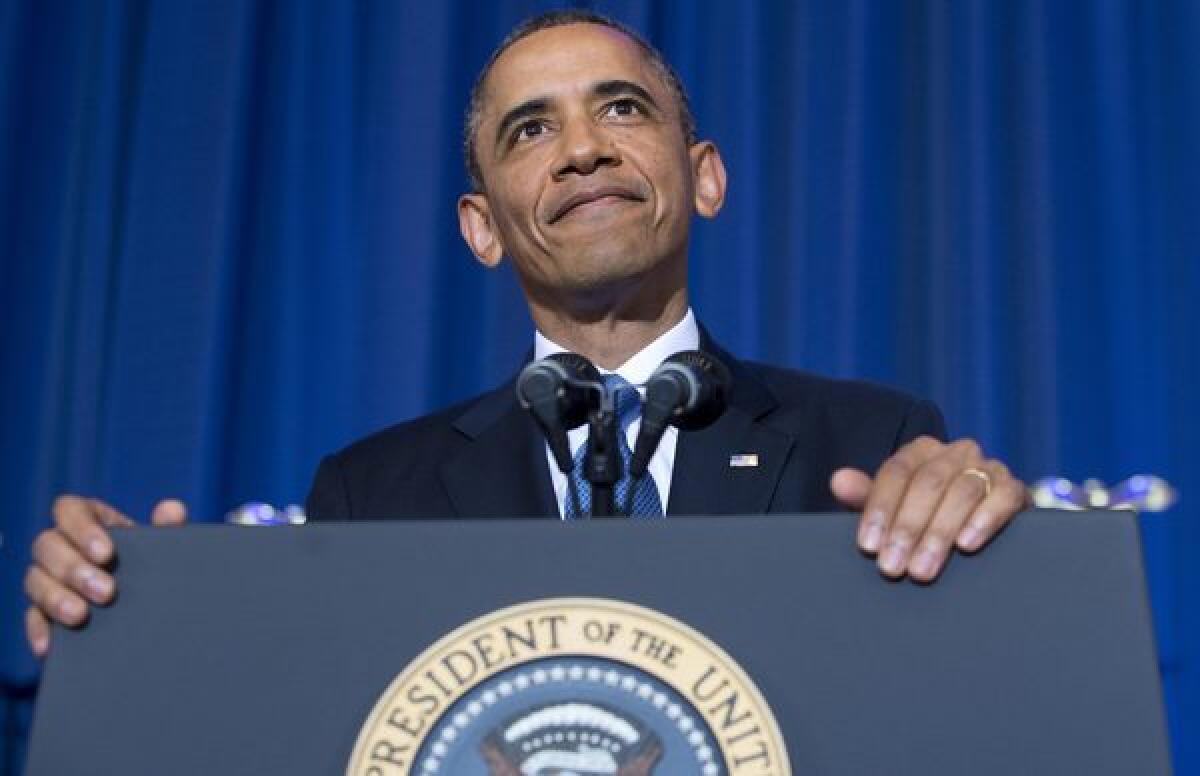McManus: Rebooting the war on terror

- Share via
President Obama’s speech last week on the future course of America’s 11-year-old war against Al Qaeda was long overdue.
Never before has he offered the public such a detailed explanation of his anti-terrorism strategy. In part, that’s surely because so much of it was officially secret — but also because the public hasn’t demanded a position more nuanced than “tough on terrorism.”
The president did three big things in his speech Thursday at the National Defense University in Washington. He argued that America’s fight against terrorism should be narrower and more sharply focused. He formalized, in particular, new limitations on drone strikes. And he promised that the war against Al Qaeda will end someday.
Predictably, Republicans instantly accused Obama of going soft. Sen. Saxby Chambliss (R-Ga.) charged that merely by giving his speech, Obama had handed the terrorists a victory.
“Rather than continuing successful counter-terrorism activities, we are changing course with no clear operational benefit,” he said.
Rep. William M “Mac” Thornberry (R-Texas) charged that Obama was proposing we could return to “a pre-9/11 sort of mentality.”
But that’s not what Obama said, and it’s not what he’s doing either. In fact, some might charge that he’s simply rebranding the war on terror; he prefers to call it “a systematic effort to dismantle terrorist organizations.”
But it’s still going to look an awful lot like war.
In Obama’s new version, there will still be drone strikes against terrorists overseas, including U.S. citizens — just fewer of them, under clearer rules.
The president will continue to assert the authority to strike anyone who threatens the United States, but maybe not militants who target other friendly governments.
And the United States will still hold dozens of detainees without trial; they may merely be moved from Guantanamo Bay, Cuba, to a prison in the United States, if Congress allows — which, by all appearances, it won’t.
That doesn’t mean Obama hasn’t made significant changes. His new rules on drone strikes, in particular, are important and useful.
Despite his image as the antiwar candidate in 2008, when Obama took office, he approved a major increase in the use of armed drones against suspected terrorists in Pakistan and Yemen, from an estimated 35 in 2008 to 121 in 2010. Officials bragged openly about the lethal effectiveness of the strikes and claimed that they were precise enough to avoid all but a few civilian casualties.
But over time, they discovered that the miracle weapon was not without costs. In Pakistan, reports of civilian casualties turned politicians and the public against the United States.
In Yemen, where the number of strikes increased from four in 2010 to 42 in 2012, U.S. drones were used not only against Al Qaeda but also as a weapon in the country’s civil war. In Somalia and other countries, U.S. officials said they were running out of legitimate targets.
And they worried that unfettered use of drones would set too lax a precedent for countries such as China and Russia that are likely to develop drones of their own.
So, last week, Obama promulgated a new rule: The United States will use drones only against suspected terrorists who pose a “continuing and imminent threat to the American people.”
That’s a notably tighter standard than one offered just a year ago by John Brennan, then a White House counter-terrorism advisor and now the CIA director, who said drones could be used against any “significant threat to U.S. interests.”
Obama also said drone strikes could now be launched only if there was a “near certainty” that no civilians would be killed, a rule that other officials said has been in effect for some time. Indeed, groups that try to monitor civilian casualties say that number has diminished — in part because fewer strikes are being launched.
Still, Obama ordered a concrete change, one that is in keeping with his overall strategy of reducing the number of wars the United States is fighting. U.S. combat troops have left Iraq and are scheduled to depart Afghanistan next year. And the president has resisted pressure to intervene in Syria.
“This war, like all wars, must end,” Obama said Thursday. “That’s what history advises. It’s what our democracy demands.”
But history also reminds us — to borrow a military saying — that the enemy gets a vote. Some wars, especially those waged by terrorist groups, can persist for decades.
Testifying before the Senate Armed Services Committee on May 16, Assistant Secretary of Defense Michael Sheehan warned that the conflict with Al Qaeda is far from over.
“In my judgment, this is going to go on for quite awhile; yes, beyond the second term of the president,” Sheehan said. “I think it’s at least 10 to 20 years.”
Obama would like to see a clear victory over Al Qaeda — call it “V-Q Day” — before he leaves office in 2017. He’s unlikely to enjoy that luxury. But, with luck, the speech he gave last week will help the nation get there — with less collateral damage along the way.
Follow Doyle McManus on Twitter @DoyleMcManus
More to Read
A cure for the common opinion
Get thought-provoking perspectives with our weekly newsletter.
You may occasionally receive promotional content from the Los Angeles Times.







